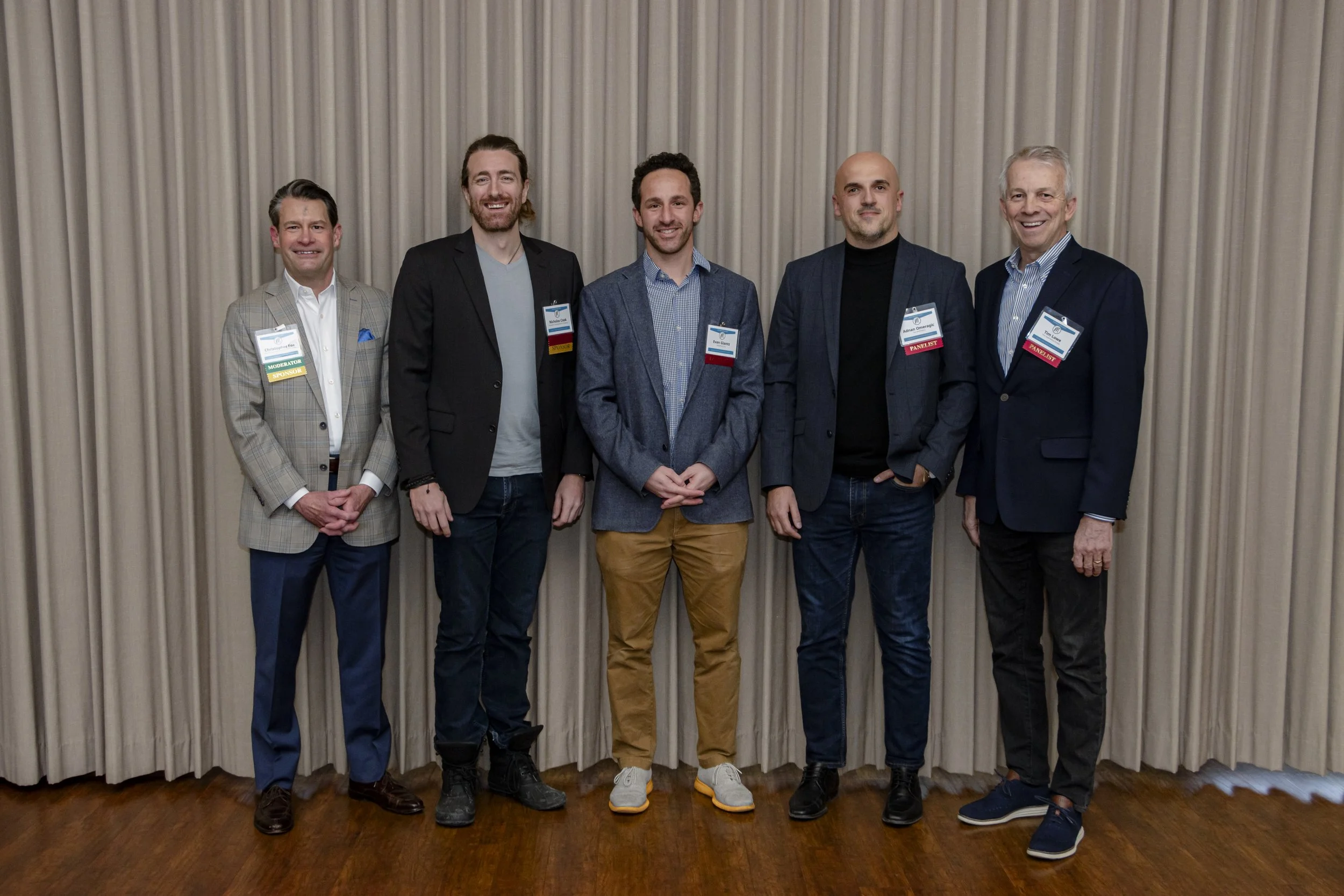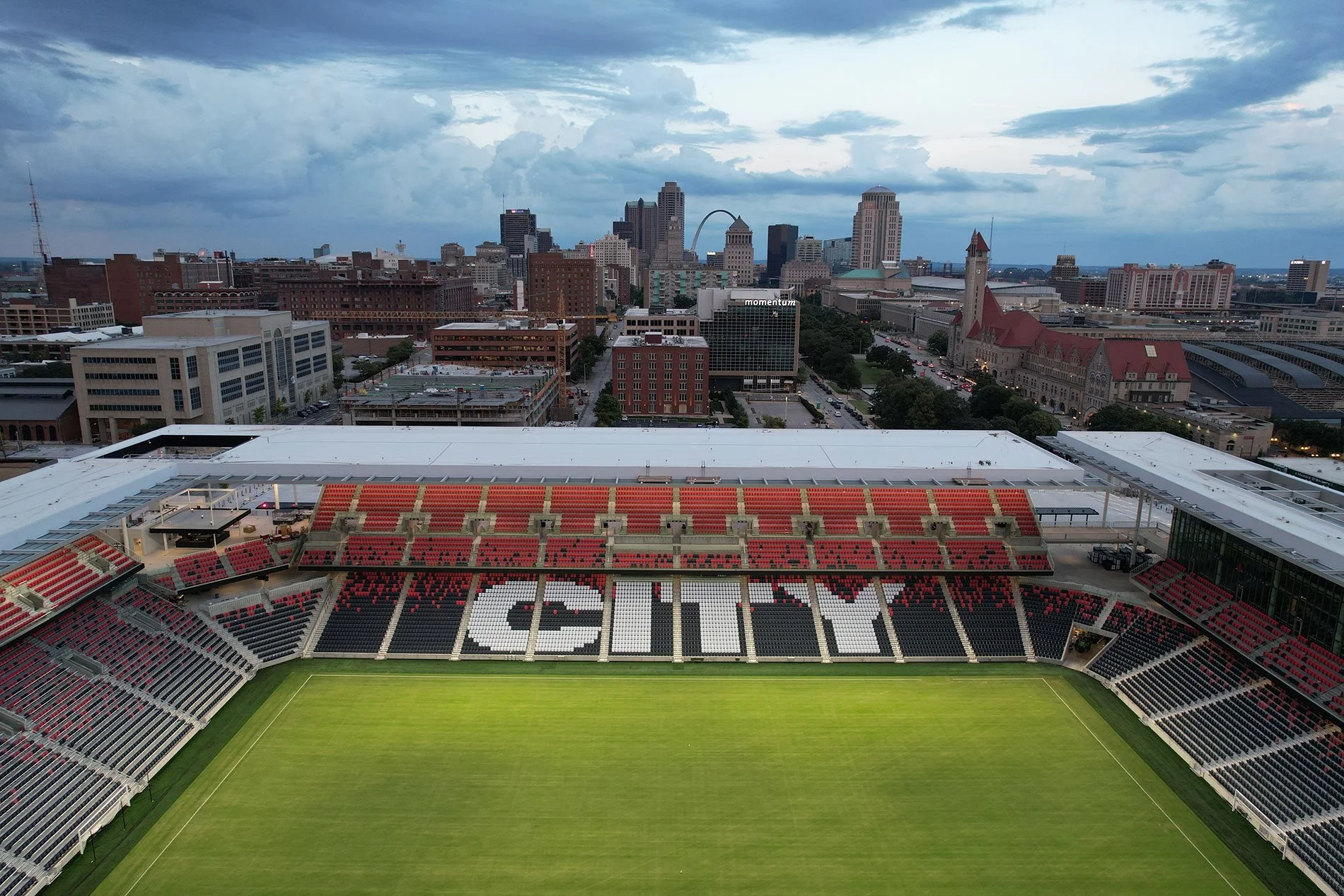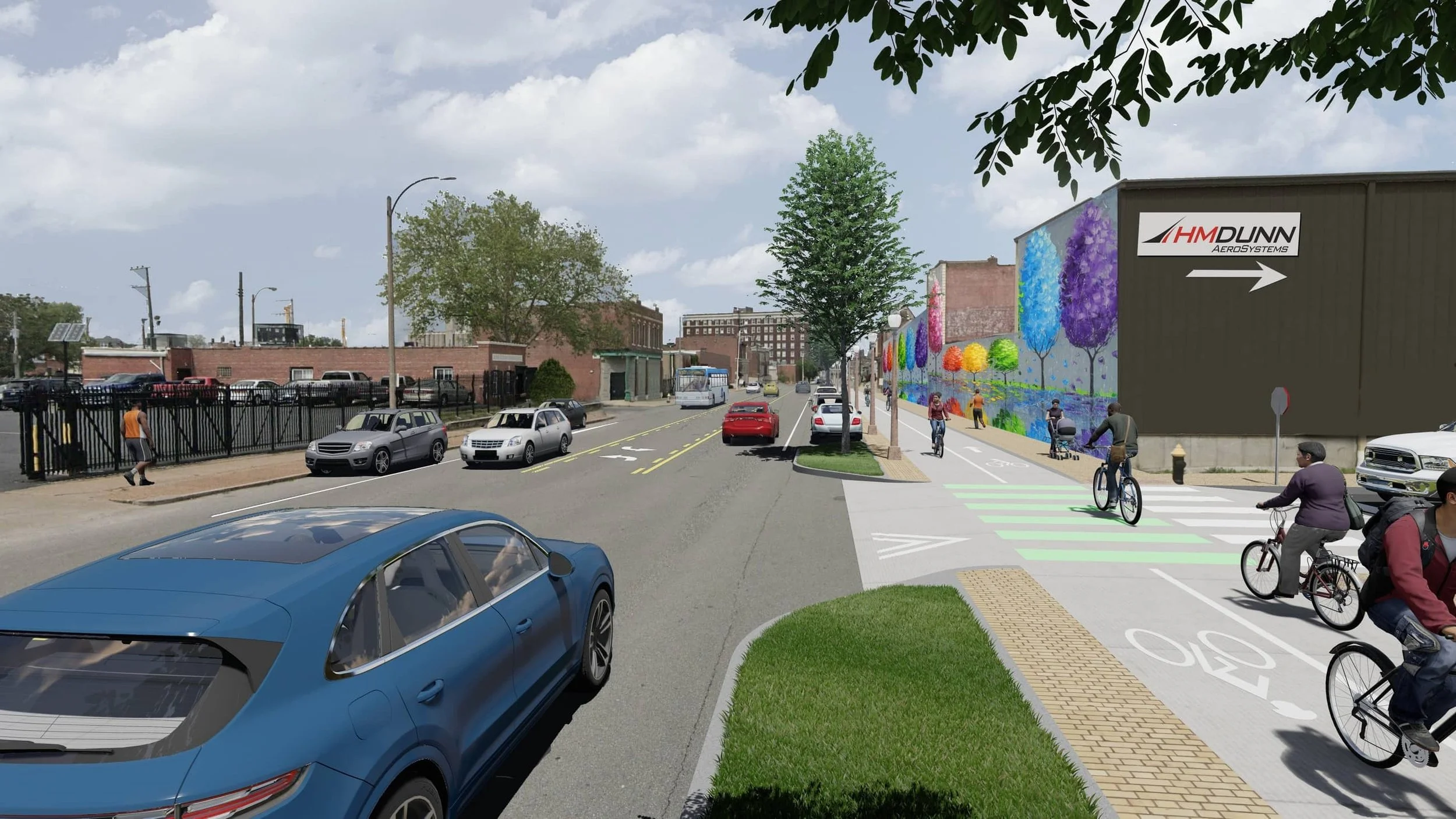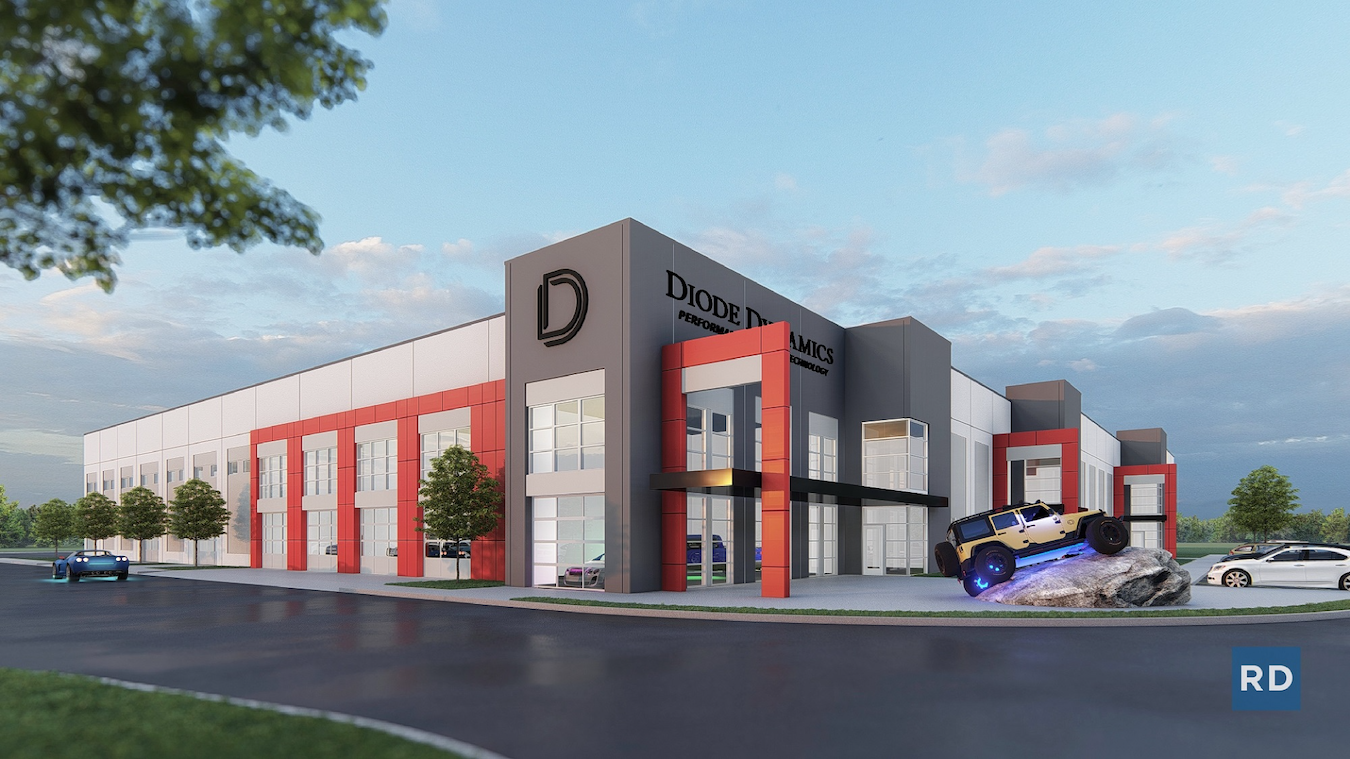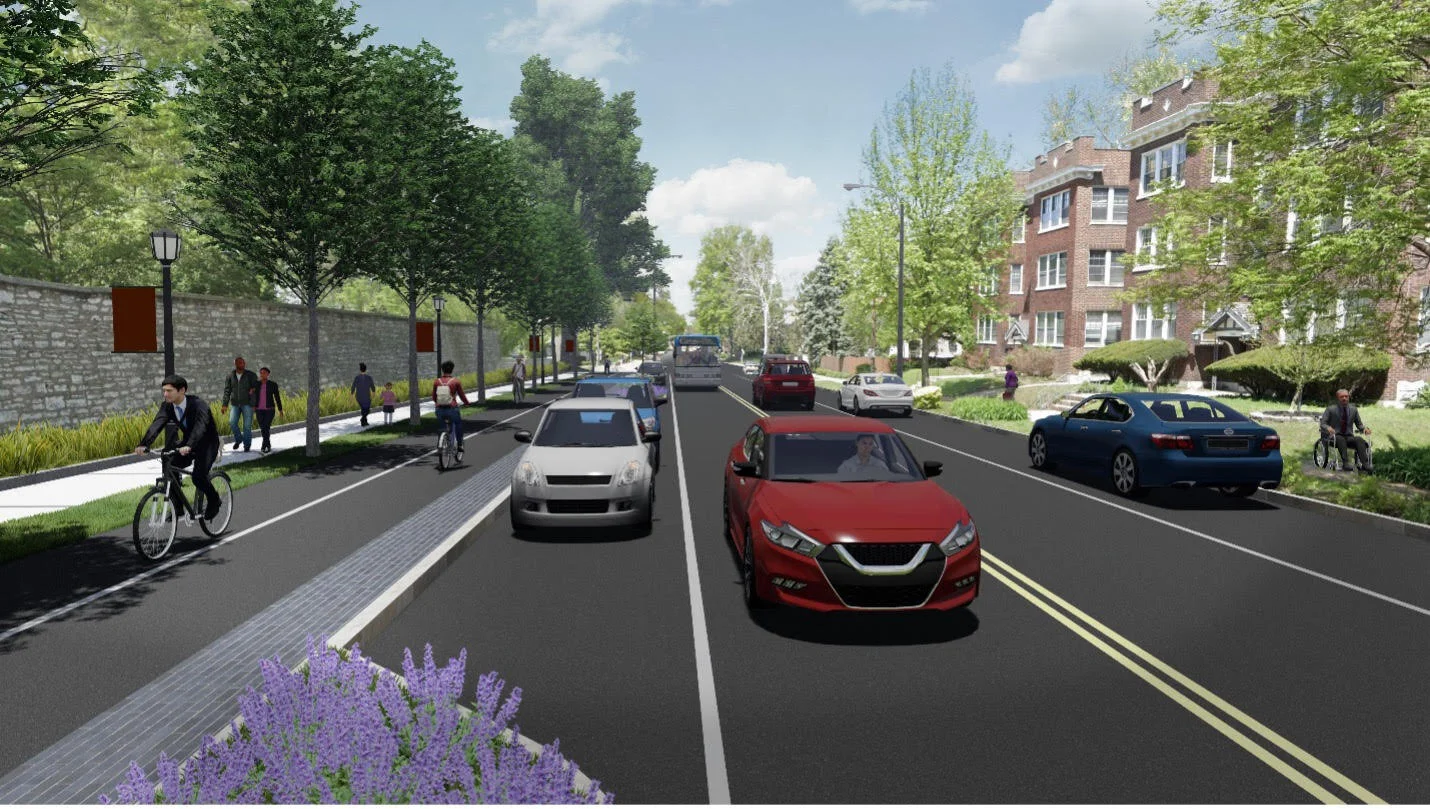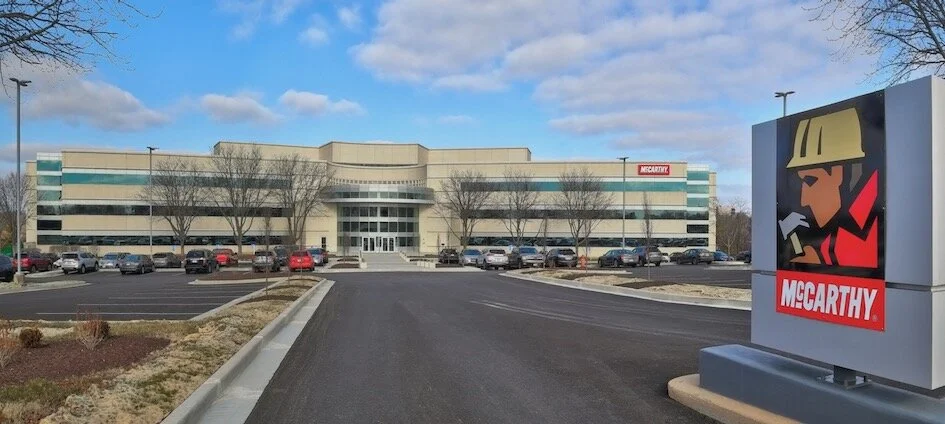Feature image(s): CITYPARK Stadium, the home of St. Louis CITY SC, is located just across the street from Union Station in Downtown St. Louis. Image courtesy of HOK
World’s largest indoor Padel and Pickleball facility opens in St. Louis
TCARE's expansion includes prime location on dedicated bike lane
FEATURE IMAGE: The Tower Grove Connector, a 1.4-mile dedicated bike lane, will run directly in front of TCARE's new facility on Vandeventer Ave. in St. Louis' Botanical Heights neighborhood, providing new infrastructure to further connect city neighborhoods. Image credit: Tower Grove Connector/www.towergroveconnector.com.
Insatiable appetite for commercial real estate continues
The St. Louis-area CRE market is still hungry for more, according to Commercial Real Estate Women (CREW)-St. Louis’ “Industrial Outlook” panelists.
Christie Brinkman, director, design build, Castle Contracting, LLC, moderated the March session as panelists, Cara Weber, Wakeel Rahman and Christy Campbell discussed recent pandemic-related challenges and predictions going forward.
Cara Weber, vice president, business recruitment, Missouri Partnership, said the Partnership is a public/private entity funded by the State of Missouri’s Department of Economic Development and the Hawthorn Foundation to focus on attracting new businesses to the state by functioning as a sales tunnel that includes marketing, business development and project management.
“Our Raise the Bar program is identifying sites for development so the region can control its own destiny,” Weber said.
In the past five years, the Partnership has opened 615 projects and lost 142. Wins by industry include advanced manufacturing, energy solutions, food solutions, logistics and distribution, and office-based space.
“Expansion is incredibly important — about 80 percent of new jobs are coming from expansion,” she said. “I’m excited about the level of project flow so far this year, which has been mostly industrial. We’re seeing a lot of searches for existing buildings, but don’t have a lot available.”
“Retention (of businesses) is the key component. Attraction is our wheelhouse,” Weber said. “We’re getting more opportunities from big OEM businesses.”
Available CRE space is a factor in lost projects, along with whether a business has an existing presence in the area and concerns about logistics, incentives, available workforce, business costs and infrastructure, according to Weber.
“What’s great about Missouri is our transportation resources: rail and river,” she said.
The CRE profession is faced with “trying to meet an almost insatiable demand for commercial real estate,” said Wakeel Rahman, vice president, NorthPoint Development. “The market is very healthy. Retail stepped up to take a lot of space to compete with Amazon.”
E-commerce is driving the market from “just in time” (JIT) to “just in case” (JIC), and the ratio of inventory to sales in the supply chain should increase.
Rahman warned that national headwinds to watch include continued supply chain delays and cost increases for materials and construction, NIMBYism (Not In My Back Yard) attitudes toward industrial properties, entitlement and permitting, and warehouse fatigue.
“St. Louis is still one of the tightest markets,” he said. “Looking forward, we will see an increase in automation and more-affordable systems; new geographies where companies can build; and spending more on infrastructure, which means good things for our industry because it creates improved access.”
The preliminary 2022 first-quarter numbers are encouraging, said Christy Campbell, brokerage associate, Cushman & Wakefield: “2.2 MSF of positive net absorption and a 2.9 percent vacancy rate — the lowest ever.” Asking rates are increasing in response, she said. “While St. Louis has always been a stable market, 2021 was a record year and we’re already halfway there in 2022, with 8.3 MSF under construction among 26 buildings with only one that’s tax-abated.”
Royal Canin, Ryder and Imperial Dade are leading the field; Duke Realty has completely left the market.
The largest Q1 investment sales have been Duke to Exeter Property Group, Inc., TriStar Properties to Apollo Global Management and Duke to Pontegadea Inversiones as cap rates continue to compress.
“Trends are an upward pressure on rental rates and annual increases, changes in marketing strategies with less and less advertised rates, increased emphasis on e-commerce, and the move from JIT to JIC,” Campbell said.
In terms of some of the issues that Rahman noted, “The most common misconception about the industrial sector is negative environmental impact of large facilities on a community; but in reality, there’s no stress on schools, there are new jobs, and LEED buildings with high-tech electronics-driven systems are environmentally friendly,” she said.
“Industrial tenants are looking for buildings with 30- to 40-foot clear heights because of racking and are making heavy trailer parking demands,” Campbell said. “Land prices are increasing across the country, although St. Louis is lagging behind the coasts.”
Upcoming CREW-STL events include Coffee with CREW, April 1; Membership Hike, April 6; Bar K & Green Street Real Estate Ventures Happy Hour and tour, April 12; and Dine Around, April 19. To register or for more event details, visit https://crewstl.org/events.
The Staenberg Group begins $70 million Metro East development
City Foundry STL moves forward with next phase
Contegra to deliver new HQ for Diode Dynamics
It's a yes! Greater St. Louis all in on Downtown revitalization projects
Grain terminal addition strengthens STL inland port
The St. Louis region’s position as the most efficient inland port in the United States has been strengthened following the recent addition of a new grain handling terminal on the banks of the Mississippi River in Cahokia, Ill., adding capacity in the area known as the Ag Coast of America.
The region garnered the title due to a 15-mile stretch of the Mississippi River featuring 15 barge-transfer facilities that, at total capacity, can handle 150 barges a day – the highest level of capacity anywhere along the Mississippi River.
The addition of the 16th terminal, which was built by American Milling and purchased in December 2020 by Oakley St. Louis, LLC, a subsidiary of Arkansas-based Bruce Oakley, Inc., further expands the existing capacity with the ability to handle at least 1,000 more truckloads of grain daily.
Bruce Oakley entered the market in 2019 with its purchase of Lange-Stegmann Company, its second terminal in the area. The acquisition gave Bruce Oakley control of Lange-Stegmann’s 60-acre site at Mile 182.7 on the Upper Mississippi River, which includes a barge dock, a rail yard with 23,000 feet of track, three locomotives, a truck and rail scale, and more than 153,000 tons of storage capacity.
“Bruce Oakley, Inc. is very excited to have a presence in the St. Louis area,” said Justin Oakley, vice president of Bruce Oakley, Inc. “For a commodity transportation and distribution company like Oakley, St. Louis is one of the most strategic locations on the river system. No other city connects river, rail, and road quite like the Ag Coast of America. Deep barge drafts, the lock-free and ice-free river to New Orleans, connection to the Class-1 railroads, and proximity to many industrial accounts that Oakley also services, make the Ag Coast a perfect location for us. Having the largest and most efficient fertilizer terminal in the area, complemented by a high-speed grain loading terminal, makes Oakley uniquely suited to add value to customers throughout the region.”
Other facilities on the Ag Coast include the Cargill Grain Elevator, which is one of the busiest grain elevators in the nation; the Bunge-SCF River Grain Terminal in Fairmont City, Ill., which is designed for more than a million bushels of permanent storage and can handle high volumes of multiple commodities simultaneously; and four facilities in Cahokia, Ill., operated by Consolidated Grain and Barge Company (CGB), Louis Dreyfus and COFCO International Growmark, which are the four highest capacity facilities in the entire inland waterway. Facilities operated by ADM, Gavilon Fertilizer, SCF, and Italgrani Elevator Company, along with America’s Central Port and the Municipal River Terminal in St. Louis, round out the 16 barge transfer facilities currently handling the tremendous volumes of agriculture and fertilizer products flowing through the Ag Coast.
Growth on the Ag Coast is also supported by the recently completed reconstruction of Cargill Elevator Road, a vital link to the terminals in Cahokia, Ill. Trucks represent 87 percent of the vehicles traversing the narrow roadway, and prior to the reconstruction, traffic had been limited to one lane in each direction. Federal funding of $800,000 through the IDOT Competitive Freight Program was key to advancing the $3.3 million project, which also received state and private funds.
“IDOT is proud to be working closely with our local stakeholders and businesses to improve the efficient transport of freight through our region,” said Keith Roberts, the acting Region Five engineer for the Illinois Department of Transportation. “The recent Cargill Elevator Road improvements complement future planned work by the department, including the extension of relocated IL Route 3 south into Sauget and additional projects to improve reliability of the freight and commuter network along this vital regional corridor.”
One additional project, now partially funded, will help to address heavy traffic volumes on Illinois Route 3 at the A&S Railroad crossing in Sauget, which result in more than 55,000 hours of through-traffic delays annually. Calculating the cost of delay, a proposed grade separation project would provide annual cost savings of $1.5 million for passenger and commercial vehicle drivers traveling this area and improve truck traffic reliability, safety and efficiency benefiting barge and rail rates. The overall project has multiple benefits to the region in terms of improving access to the growing business community and encouraging future business development.
Mary Lamie, vice president of Multi Modal Enterprises for Bi-State Development and head of the St. Louis Regional Freightway enterprise, is excited about the continued investment in the Ag Coast and the infrastructure surrounding it.
“Handling nearly 450,000 tons per mile, the St. Louis region’s port system is almost two and a half times more efficient on its river usage than its closest competitor, according to the most recent rankings by the U.S. Army Corps of Engineers,” said Lamie. “The added capacity and enhanced access provided by the newest terminal and infrastructure investments will come in handy given projections that 2021 will be a record year for corn and soybean exports from the United States.”
Tower Grove Connector asks for public feedback
Holland Construction completes O'Fallon senior living development
Holland Construction Services has completed work ahead of schedule on the new Keystone Place at Richland Creek Senior Living Development in O’Fallon, Ill.
The $39 million development, located at the northwest corner of Frank Scott Parkway and Fountain Lakes Drive, offers independent living, assisted living and memory care services in one location.
The four-story building has 149 apartments; including 64 independent-living, 66 assisted-living and 19 memory care, plus one guest suite. The five-acre development also features a memory garden, a courtyard and a formal entrance lobby facing Fountain Lakes Drive.
“This development offers a much-needed, new rental housing option for older adults seeking a safe, secure, maintenance-free, service-rich lifestyle and we’re very excited that it was completed ahead of schedule,’ said Timothy Eldredge, president of NASCON Senior, LLC and co-founder of Keystone Senior Management Services, Inc.
The 170,000-SF development was constructed adjacent to Parkway Lakeside Apartments, which Holland completed several years ago.
“Our team has an incredible amount of experience handling multifamily and senior living projects that require different care levels and because of that background, we were able to ensure this development met the intended use for the building and the project ran smoothly,” said Holland project manager, Rob Ruehl.
“Keystone Place at Richland Creek’s ultra-inclusive service package provides meals, housekeeping, transportation, and life enrichment opportunities that allow residents to engage, explore and maximize their personal wellness, even in a time of social distancing,” said Jan Brenner, Keystone Place at Richland Creek’s Senior Living counselor.
“With residents and staff vaccinated at this point, people are really seeking opportunities to socialize and connect with others again, and that’s the idea behind the Keystone Place lifestyle,”
The community is hosting open house events on April 17 and 18 by appointment. For more information about Keystone Place at Richland Creek or to schedule an open house visit, call (618) 576-6178.
$47 million hotel construction begins in Clayton
Ryan Companies breaks ground on multi-specialty medical building in St. Peters
Vision for greatness ahead for St. Louis
St. Louis commercial real estate should be headed for great things in 2021, judging by insights provided in “Greater St. Louis and a Vision for Greatness,” a March 9 Retail Spotlight Shift webinar from the St. Louis CCIM chapter.
Tiffany Wiegers, 2021 president of CCIM STL, kicked off the event by thanking sponsors as critical to providing services and resources for the chapter and announcing that scholarships are available for upcoming courses (details are on the CCIM STL website).
Events hosts were Tony Kennedy of Colliers International and Tom Ray of CBRE.
“This is a timely and important discussion about the future of our region,” said Greater St. Louis, Inc. founder and CEO Jason R. Hall, in describing Greater St. Louis Inc. as a combination of five organizations (AllianceSTL, Arch to Park, Civic Progress, Downtown STL, Inc. and the St. Louis Regional Chamber) aiming to reduce historic fragmentation and create one united voice.
“We have to make a decision that we will be a community on the rise or on the decline. We need the same vision, same tenacity, same energy (as in the sports sector) to grow the region.”
“Greater St. Louis brought together eight key growth initiatives from day 1 (January 1, 2021),” Hall said. “It’s all about jobs — retain, attract and create; elevate our regional reputation; and advance common goals. The urban core is essential.”
Among the positive indicators, St. Louis has seen $8 million in commercial real estate during the pandemic.
“And that has continued to grow. St. Louis can be a global leader in biotech and agtech,” Hall said.
An important example is the 1,400 new jobs coming with Accenture. Other encouraging signs are redevelopment of the Butler Building, which has been one of downtown’s largest vacant buildings, and Green Street Workforce Housing, a partnership for “one of the largest inclusive housing projects in The Grove.
Such place-making projects have a huge impact on bringing business and residential growth to St. Louis.
“We are coming together as a geospatial center of excellence, with a long-term plan in place,” Hall added.
Hall cited entrepreneurship as another incredible force in being re-energized.
“St. Louis is launching new businesses and is first in the country for women-owned businesses,” he said. “We are aggressively back in business.”
Hall quoted Entrepreneur magazine as recently saying that “St. Louis is on the precipice of leading the United States in 21st-century innovation.”
While the St. Louis area hasn’t had a basic jobs plan for more than a decade, “we are now the only metro area to develop one in terms of the pandemic and the new civil rights movement,” Hall said.
“We have to drive inclusive growth. We have got to focus on inclusive growth and close spatial and racial gaps.”
Greater St. Louis is funded by private sector business as investors, and “the business community has to be much more engaged to make (our vision) a reality,” Hall noted.
“We have to make St. Louis better overall and understand the perception of St. Louis in the country. We started STLMade as a way to shine a light on the positive and tell our own story. We will take the story national. It’s a people-centered, data-driven approach.”
In line with such efforts, the AllianceSTL partnership aims to “accelerate growth by recruiting new jobs and business investments to the 15-county bistate St. Louis region,” according to Chief Business Attraction Officer and president Steven S. Johnson.
“We have an exclusive external focus on business and economic development,” he said. “Our key audiences are site selectors, real estate developers and companies in our main targeted verticals: manufacturing and production; financial and information services; bioscience and health technology; geospatial; agtech; transportation and logistics; and the aerospace, automotive and defense industries.”
Many of those targets are in local commercial real estate because of their current work in location services, Johnson noted.
The Alliance is using social media and related advertising along with traditional advertising to those primary key audiences, along with individual outreach and relationship-building. Marketing is essential — a lesson that St. Louis is learning from cities like Austin, Texas. “Many of the markets we admire have been marketing business attraction for decades.”
Typical projects for the Alliance include “straight-up business development to attract companies and headquarters to St. Louis,” which represents 80% of its focus. Such companies are generally new to the area or have no St. Louis presence yet. Cooperation is vital: “We work with economic development partners; we can do nothing by ourselves,” Johnson said. “Our relationships and partnerships are as strong now as ever, and that is good for St. Louis.”
To build on those connections, “we ask businesses exactly what they’re look for.” The answer is usually “talent availability and sourcing, business continuity, and the cost of labor. “We are finding that location is as much about mitigating risk as anything else,” Johnson said.
Agriculture technology is another important business sector for St. Louis, thanks to its central location and accessibility to a huge resource of agricultural producers, according to Thad Simons, founder and managing director of The Yield and The Yield Lab Institute, a “cooperative network of venture funds to advance food and agriculture technology globally,” with companies in Ireland, Argentina, Brazil, Chile, Singapore, France and Luxembourg. The lab is the company’s nonprofit arm.
When he came to St. Louis in 2014 for a three-year assignment with Monsanto, “I was curious about the agtech space,” Simons recalled. “I realized the difficulty of getting projects off the ground. Part of the problem was understanding what ‘agtech’ means.”
With agriculture as one of the largest elements of the geospatial sector, the advantage for St. Louis is that it is “right in the center of agricultural production and distribution. The strength we bring is less the money that the connections,” Simons said. “The impact of the agriculture sector on St. Louis is tremendous.”
While many large organizations already have a local presence — the largest associations for farmers are all based in St. Louis, “we mentor smaller companies to come to St. Louis.” There is still a need to “find champions of St. Louis and stay in touch with them,” Simons said. He is encouraged by the expectation that “there will be lots of stories of companies coming here through word of mouth.”
Simons sees St. Louis as a “really hot space” that is “fostering research and technology.” Of the company’s 50 global projects, 12 are in St. Louis. Driving new investment and presence in the area are projects and innovations that go beyond traditional uses of agricultural products, such as a commercially viable indoor farm and “a small-scale project along Delmar to address food deserts” (the absence of grocery stores). “It’s intended to be for-profit, so we will sell products to restaurants, but also donate to the community,” he said.
Now getting started in St. Louis is a NASA Challenge to investigate “how growing food in space can relate to growing food on Earth,” Simons added.
While Simons is optimistic about business growth, he sees a need for expanded investment. “St. Louis is strong and getting stronger in human capital, but still not where we should be in financial capital,” he said.
The hemp industry offers the prospect of growth as an alternative protein and in oils and nutrition, once regulation and legality are in place.
Looking ahead
For St. Louis business and commercial real estate to succeed, it is crucial “to be thinking five, 10, 20 years ahead to create self-perpetuating environment in geospatial and build up an innovation ecosystem,” said Hall. “That will give St. Louis a durable advantage.”
Asked about the impact of a new mayor on commercial real estate and business, Hall said the upcoming mayoral election is a “generational change; both candidates are speaking about growth and the need for inclusional growth. It’s an exciting time for St. Louis. Magic happens when we have public and private alignment. There will be exciting opportunities to work together.”
“We seem to have two candidates who will be very hands-on and pro-development. We will work with everybody,” Johnson said.
“Whoever becomes mayor will have to realize that there is an urban-rural divide, and a need for much better understanding between those segments of the region,” Simons said.
A recording of the event is available at https://www.linkedin.com/company/ccim-st-louis-metro-chapter/ or
https://www.youtube.com/channel/UCO2uJM-RnLRetiKTNvYAUVA.
McCarthy moves national headquarters to new office space
Green Street, HDA to HQ in new $20 million Bar K facility
Following the acquisition of HDA Architects by Green Street St. Louis (“Green Street”), the firms plan to combine offices this fall as part of the $20 million Bar K redevelopment at 4565 McRee Avenue in St. Louis, Mo.
The 64,000 SF redevelopment will include Kansas City-based Bar K’s first St. Louis dog park and entertainment facility featuring extensive indoor and outdoor areas for supervised dog play adjacent to bar, restaurant and event space.
Green Street and HDA’s combined offices will occupy approximately 31,000 SF on the first floor and mezzanine level of the building to house approximately 50 employees.
“We can’t wait to bring the Bar K experience to the people and dogs of St. Louis,” said Leib Dodell, the company’s co-founder. “The facility is going to be paradise for dog lovers, and we couldn’t be happier that Green Street and HDA will be part of our new community.”
In addition, Bar K will create a dog adoption and pet education facility in partnership with St. Louis-based Purina-owned pet-adoption site Petfinder.com, as well as Stay@Bar K, a 6,700 SF daycare and grooming facility in collaboration with St. Louis-based Kennelwood.
The development is the first of two phases planned for the McRee area. Green Street is considering its options for the redevelopment of the adjacent six acres at 4591 McRee Avenue.
Bar K is being designed by Arcturis with construction managed by Green Street Construction. HDA is designing the office component with interiors by O’Toole Design and Green Street Building Group managing construction. Civil engineering is being performed by Stock & Associates Consulting Engineers, Inc. with environmental consulting by ATON Environmental.
Emerald Capital Strategic Advisors assisted Green Street in sourcing and closing $18M in New Markets Tax Credit Allocation to support the project. Green Street also utilized other forms of non-traditional capital such as Opportunity Zones Investments to allow the project to move forward.
The dog park, grooming salon and daycare will create nearly 200 jobs and construction on the project will create 150 jobs.
$40 million affordable housing project heads to Central City
Building on continued momentum in St. Louis’ Central City, a groundbreaking new housing project will bring attainable housing through over 160 new units - over 80 of which will be workforce-targeted rents - to the Central City’s Forest Park Southeast neighborhood.
Union At The Grove, a $40 million multifamily development, is comprised of six individual buildings on Hunt, Vista and Norfolk Avenues, between Newstead and Taylor Avenues, just east of Kingshighway.
Green Street St. Louis developed the project with support from a consortium that includes Greater St. Louis, Inc., IFF, and Washington University Medical Center Redevelopment Corp. (WUMCRC), a partnership between BJC Healthcare and Washington University School of Medicine in St. Louis.
“As we focus on inclusive economic growth for our region, the project sends a strong signal about what is being done to begin a resurgence in the Central City in St. Louis,” said Valerie E. Patton, Chief Diversity, Equity and Inclusion Officer for Greater St. Louis, Inc. and president of the Greater St. Louis Foundation.
In addition to Union, recent developments highlighting the resurgence in the Central City include the first fully protected bike and pedestrian infrastructure in the city that will connect the Tower Grove Park and the Shaw neighborhood to Forest Park Southeast and Cortex; continued significant development taking place in and around Cortex itself; the construction of the new NGA West headquarters, projected to open in 2025; and additional hundreds of millions of dollars of new and adaptive re-use real estate development underway in the City. As has been reported in recent years, more than $8 billion in development is underway, planned or has been recently completed in the City.
“Union At The Grove is a natural extension of Green Street’s continued commitment to the City of St. Louis and Midtown redevelopment through partnership and community revitalization,” said Joel Oliver, Green Street senior vice president for development.
Developing new workforce housing is critical to inclusive growth, and approximately 52 percent of the Union’s units will have attainable rents so that health care employees and medical school staff can live near where they work. The units with attainable rates will be blended throughout each of Union’s six unique buildings.
Amenities include private entrances, courtyards and walking paths; shared rooftop terraces, balconies, and barbecue areas; and bike storage, mail, and secure package areas. The properties are walking distance from Forest Park, Tower Grove Park, Cortex and the Washington University Medical Campus.
“Social, environmental and economic inequities are recognized as major contributors to health disparities,” says Richard Liekweg, BJC HealthCare president and CEO.
“This project demonstrates that health care organizations can play a part in strengthening our neighborhoods and communities. Having new, attractive and attainable housing adjacent to our academic campus where some 20,000 employees work will facilitate access to jobs, while also strengthening communities,” Liekweg said.
Beginning in 1996, WUMCRC has purchased properties in the neighborhood with the long-term goal of attracting developers with strong records in redeveloping and supporting mixed-income, diverse communities. Union At The Grove is the final segment of this effort to improve the quality of life for residents in neighborhoods that border the Medical Campus. WUMCRC also has supported neighborhood investments in safety, jobs, education and the development of The Grove, the entertainment and commercial district along Manchester Road.
“In recent years the market has done a great job supplying high quality market rate and we have been able to find resources to build and maintain low-income housing units in the neighborhood. This project fills in the missing middle – those who earn too much to qualify for subsidized housing and too little to afford market housing,” said Hank Webber, Washington University’s executive vice chancellor and chair of the WUMCRC board.
Construction is slated to start February 1, 2020 with an official groundbreaking ceremony targeted for spring of this year. The project did not make use of federal or state tax credits or incentives and is applying all funds from the 10-year tax abatement it received into the newly formed Newstead West Community Improvement District for the purpose of making infrastructure improvements that would otherwise not be completed. These improvements include:
Resurfacing of streets and alleys
Rebuilding sidewalks and curbs
Installing new streetlights
Helping heal the City’s grid by reopening the cul-de-sacs on Vista and Norfolk at Taylor
“This development checks a couple of important boxes for our community. It adds density to support our efforts for more environmentally sustainable development and less car dependency. It also has a workforce housing component to assure our neighborhoods remain economically diverse. Both are core values of the 17th Ward,” said 17th Ward Alderman Joe Roddy.
Development of Union is being led by Green Street, which has advanced approximately $100 million worth of other projects in the Forest Park Southeast neighborhood. Green Street Building Group is managing project construction with said construction financing provided by Colliers International, arranged by Kyle Howerton of George Smith Partners.
IFF provided Newstead West Community Improvement District a bridge loan to provide upfront funding for infrastructure improvements that would have otherwise been available spread out over a decade.
CentralCitySTL is an initiative of the newly formed economic development organization Greater St. Louis, Inc. that combines the work of Arch to Park and Design Downtown STL. The Arch to Park Equity Fund made a patient capital investment to help make this major development possible.
Francis Howell School District begins $91 million building program
Holland Construction begins $4 million Carlyle High School addition
Holland Construction Services has begun construction on a $4 million addition to Carlyle High School, located at 1461 12th Street in Carlyle, Ill.
The project includes a 10,000-SF building addition, including a new multi-purpose cafeteria and kitchen area as well as offices, bathrooms and a lobby.
Holland project manager Brian Dayton and his team worked closely with the design team of Ittner Cordogan Clark Group as well as school administrators to ensure the new space would be multifunctional.
“This is the type of project where our specialized knowledge and expertise on educational construction projects can be very useful,” said Dayton.
“Quality, durability, flexibility, safety and cost control are always top of mind on a project like this. Our goal is to make sure we are creating an addition that will meet the district’s needs from both a budget and functionality standpoint. The entire team has been very pleased with how this addition has progressed.”
The new multi-purpose room will have multiple benefits including allowing high school students to eat lunch inside the school building as opposed to leaving campus. It will also allow for a new entrance to the school offices with a secured entry vestibule which improves school security.
Carlyle School District superintendent, Annie Gray, who took over as superintendent after the project was already underway, said the project is going to make the most of the space.
“It's never easy to step into the middle of a major construction project, especially while also dealing with COVID-19,” said Gray. “However, Holland has done an excellent job of keeping me filled in on all the progress and has been extremely responsive to any questions I might have. These additions, especially the added security features, will be a tremendous benefit to our staff and students.”
Other partners on the high school addition included Millenia Professional Services of Illinois, Cordogan Clark & Associates, BRiC Partnership, William S. Ford & Associates and Quality Testing & Engineering, Inc.
The project is expected to be complete by January 2021.



